The Standing Desk Market is estimated to be valued at USD 8.7 billion in 2025 and is projected to reach USD 14.8 billion by 2035, registering a compound annual growth rate (CAGR) of 5.5% over the forecast period. This growth is supported by a steady CAGR of 5.5%, driven by increasing awareness of the health benefits of standing while working, and a rising focus on ergonomic office solutions. In the first five-year phase (2025–2030), the market is expected to grow from USD 8.7 billion to USD 11.3 billion, adding USD 2.6 billion, which accounts for 42.6% of the total incremental growth, fueled by the adoption of hybrid working models and the growing demand for ergonomic furniture in both corporate and home office settings.
The second phase (2030–2035) contributes USD 3.5 billion, representing 57.4% of incremental growth, reflecting sustained demand for standing desks as flexible workspaces and corporate wellness programs continue to grow. Annual increments increase from USD 0.5 billion in early years to USD 0.7 billion by 2035, as companies and individuals prioritize productivity and health. Manufacturers focusing on design innovations, adjustable features, and ease of use will capture the largest share of this USD 6.1 billion opportunity.
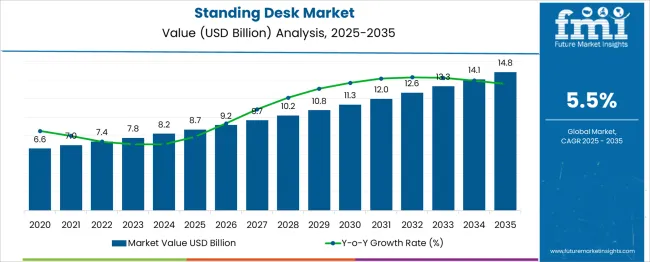
| Metric | Value |
|---|---|
| Standing Desk Market Estimated Value in (2025 E) | USD 8.7 billion |
| Standing Desk Market Forecast Value in (2035 F) | USD 14.8 billion |
| Forecast CAGR (2025 to 2035) | 5.5% |
The growing concern over sedentary lifestyles and their impact on posture, productivity, and chronic health conditions has driven demand for height-adjustable and flexible workstation solutions. Increased adoption of remote and hybrid work models has further amplified the need for customizable home-office setups. Rising corporate wellness programs and employer investment in preventive health infrastructure have also contributed to the increased penetration of standing desks.
Advancements in motorized adjustment systems, material durability, and sustainability practices are reshaping product development strategies across the industry. As consumer behavior shifts toward proactive wellness and functional aesthetics, the market is expected to maintain steady growth, supported by innovations in design, smart desk integration, and global workplace transformation initiatives..
The standing desk market is segmented by product type, material, traditional desks, price range, distribution channel, and geographic regions. By product type, the standing desk market is divided into Electric, Fixed, Manual, and Others (Converter, etc.). In terms of material, the standing desk market is classified into Wood, Metal, Glass, Composite material, and others (Bamboo, etc.). Based on traditional desks, the standing desk market is segmented into L-Shaped desks, U-Shaped desks, and convertible desks. The price range of the standing desk market is segmented into Commercial, Residential, and Industrial. The distribution channel of the standing desk market is segmented into online and offline. Regionally, the standing desk industry is classified into North America, Latin America, Western Europe, Eastern Europe, Balkan & Baltic Countries, Russia & Belarus, Central Asia, East Asia, South Asia & Pacific, and the Middle East & Africa.
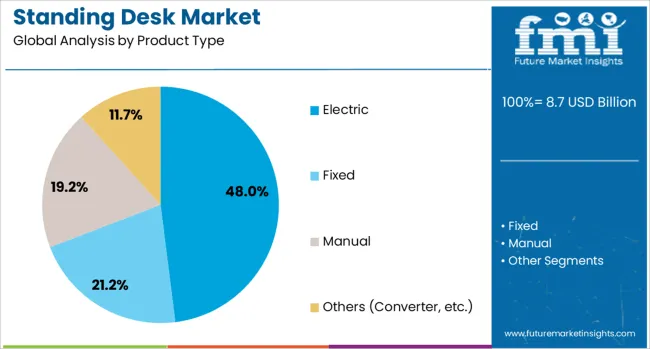
The electric product type segment is anticipated to hold 48% of the Standing Desk market revenue share in 2025, positioning it as the leading product type. Growth in this segment has been attributed to its superior ease of use, programmable settings, and smooth height transition mechanisms that support ergonomic flexibility.
Unlike manual alternatives, electric standing desks are equipped with motorized lift systems that allow seamless switching between sitting and standing positions, enhancing user comfort and productivity. Increased demand for smart and automated furniture solutions in both residential and commercial office environments has accelerated the preference for electric variants.
Moreover, the segment has benefited from integration with digital interfaces, such as memory presets and posture reminders, which align with modern wellness and technology trends. As employers seek to improve employee engagement and health outcomes, investment in electric standing desks has been prioritized, supporting its continued leadership in the product type category..
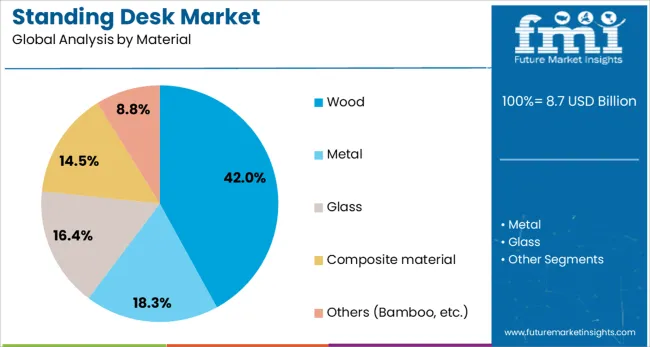
The wood material segment is projected to account for 42% of the Standing Desk market revenue share in 2025, establishing it as the most preferred material choice. This dominance has been reinforced by consumer preference for natural aesthetics, sustainability, and long-lasting durability associated with wood-based furniture.
Wood offers a warm, premium appearance that complements both home and office environments, contributing to its popularity in aesthetically driven purchase decisions. Additionally, the rising focus on environmentally responsible sourcing has driven demand for sustainably harvested or reclaimed wood materials.
Manufacturers have increasingly adopted wood as a versatile base for customizable and high-end desk configurations that align with modern design trends. As consumers seek products that combine functional utility with visual appeal, wood-based standing desks have emerged as the optimal material segment, capturing sustained interest across residential and commercial markets..
The traditional desks product type segment is expected to contribute 41% to the Standing Desk market revenue in 2025, positioning it as a major category within the product landscape. This growth has been supported by the continued relevance of simple, linear desk formats that offer a balance between functionality and affordability.
Traditional standing desks have maintained their appeal due to their space efficiency, straightforward assembly, and compatibility with various office layouts. As organizations retrofit existing office environments to accommodate standing desk solutions without major infrastructure changes, traditional models have served as a cost-effective and scalable option.
Their ability to integrate essential ergonomic features without complex customization has ensured consistent adoption, particularly among budget-conscious enterprises and home-office users. Continued focus on practical, minimalistic design and broad market accessibility has sustained the traditional desks segment as a cornerstone of the standing desk product range..
The standing desk market is driven by rising demand for ergonomic office solutions and is further fueled by the growth of remote work and wellness programs. Opportunities in adjustable and smart desk trends continue to shape the market. However, challenges like high costs and space limitations may hinder adoption. By 2025, addressing these barriers will be key to ensuring sustained growth and broader market access.
The standing desk market is growing due to the increasing demand for ergonomic office furniture. As more people work from home or spend extended hours at desks, the need for furniture that promotes better posture and reduces back pain is rising. Standing desks are seen as a solution for improving workplace health and productivity. By 2025, the market is expected to continue expanding as businesses and individuals prioritize comfort and well-being in office setups.
Opportunities in the standing desk market are increasing with the rise of remote work and corporate wellness programs. As more companies adopt flexible work-from-home policies, employees are seeking ways to improve their home office setups, including investing in standing desks. Corporate wellness initiatives, which promote healthier working environments, are also driving adoption. By 2025, these trends are expected to create substantial growth opportunities in the market, particularly in sectors that prioritize employee health.
Emerging trends in the standing desk market include the growing popularity of adjustable and smart standing desks. Adjustable desks that allow users to switch between sitting and standing positions are gaining traction, providing flexibility and comfort. Smart desks, integrated with technology that tracks user activity and provides reminders to stand, are also gaining attention. By 2025, these trends are expected to become dominant in the market, as users seek personalized, tech-driven office solutions.
Despite growth, the standing desk market faces challenges related to high costs and limited space in home offices. While standing desks provide health benefits, their higher price point compared to traditional desks can limit adoption, particularly among cost-conscious consumers. Additionally, in smaller living spaces, the large footprint of some standing desks may discourage use. Overcoming these challenges through cost-effective, compact solutions will be crucial for expanding the market by 2025.
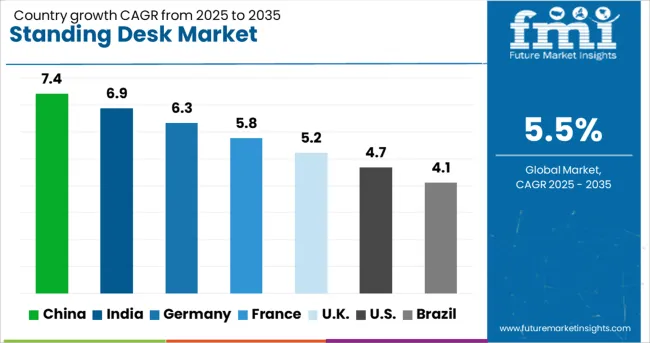
| Country | CAGR |
|---|---|
| China | 7.4% |
| India | 6.9% |
| Germany | 6.3% |
| France | 5.8% |
| UK | 5.2% |
| USA | 4.7% |
| Brazil | 4.1% |
The global standing desk market is projected to grow at a 5.5% CAGR from 2025 to 2035. China leads with a growth rate of 7.4%, followed by India at 6.9%, and Germany at 6.3%. The United Kingdom records a growth rate of 5.2%, while the United States shows the slowest growth at 4.7%. These varying growth rates are influenced by factors such as increasing health consciousness, growing remote and flexible work culture, and demand for ergonomic office solutions. Emerging markets like China and India are witnessing higher growth due to rapid urbanization, rising disposable incomes, and the adoption of healthier work habits, while more mature markets like the USA and the UK experience steady growth driven by established demand and office ergonomics. This report includes insights on 40+ countries; the top markets are shown here for reference.
The standing desk market in China is growing at a rapid pace, with a projected CAGR of 7.4%. China’s increasing urbanization, rising disposable incomes, and growing awareness of the health risks associated with prolonged sitting are key factors driving the adoption of standing desks. The country’s evolving corporate culture, with a focus on employee wellness and ergonomic office solutions, is further accelerating market growth. Additionally, the growing remote work culture in urban areas and the demand for flexible workspaces are boosting the need for standing desks in both commercial and home offices.
The standing desk market in India is projected to grow at a CAGR of 6.9%. India’s expanding corporate and technology sectors, coupled with increasing awareness about health and wellness, are driving the demand for standing desks. With the rise of flexible workspaces, growing remote work trends, and a focus on ergonomics in the workplace, standing desks are becoming a preferred choice in offices. Additionally, the increasing disposable income, urbanization, and demand for healthier lifestyle options further contribute to the growth of the standing desk market, particularly in metropolitan cities.
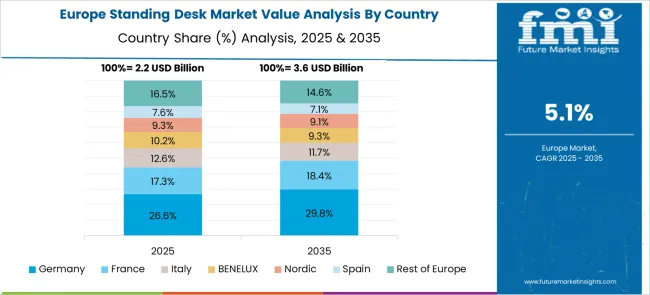
The standing desk market in Germany is projected to grow at a CAGR of 6.3%. Germany’s well-established corporate sector, along with its emphasis on employee well-being, is driving demand for ergonomic office solutions like standing desks. The growing awareness of the health benefits of standing during work, particularly in response to sedentary office lifestyles, contributes significantly to market growth. Furthermore, the demand for standing desks is supported by Germany’s focus on sustainable workspaces and innovative office designs, as well as the country’s strong manufacturing base for office furniture.
The standing desk market in the United Kingdom is projected to grow at a CAGR of 5.2%. The UK’s growing emphasis on employee wellness, combined with the rising demand for ergonomic office furniture, supports steady demand for standing desks. With the increasing adoption of flexible work arrangements, the need for adaptable and space-efficient office furniture, such as standing desks, is on the rise. Additionally, growing awareness of health issues related to sitting for long periods and the increasing popularity of remote work contribute to the ongoing expansion of the market.
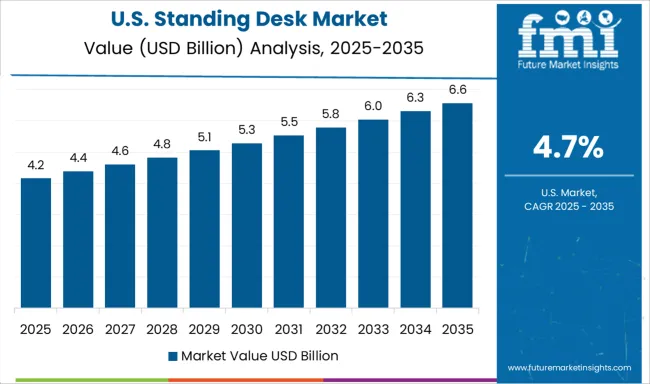
The standing desk market in the United States is expected to grow at a CAGR of 4.7%. Despite being a mature market, the USA continues to see steady demand for standing desks driven by increasing awareness of the health benefits of standing during work hours. The rising focus on reducing sedentary office behavior, coupled with the growing trend of remote and hybrid work models, is contributing to the ongoing adoption of standing desks in both commercial and home offices. Additionally, the USA market is supported by innovations in standing desk designs and functionalities that cater to a wide range of work environments.
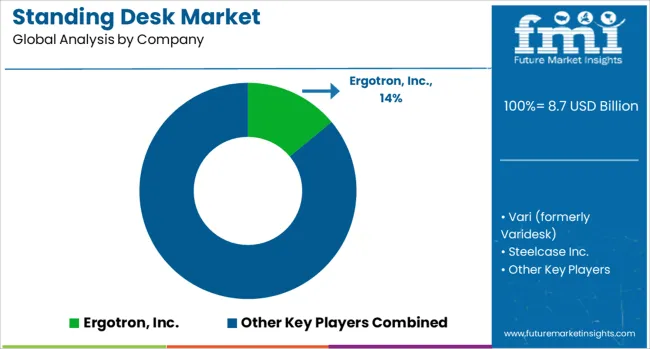
The standing desk market is dominated by Ergotron, Inc., which leads with its diverse portfolio of ergonomic standing desk solutions designed to improve employee health and productivity. Ergotron’s dominance is supported by its innovation in adjustable desk technologies, strong brand recognition, and wide customer base spanning office environments, home offices, and healthcare sectors. Key players such as Vari (formerly Varidesk), Steelcase Inc., and Herman Miller maintain significant market shares by offering high-quality, customizable standing desks that provide both functionality and aesthetic appeal.
These companies focus on enhancing ergonomic features, easy adjustability, and durability to meet the rising demand for healthier workspaces. Emerging players like Uplift Desk, IKEA, and FlexiSpot are expanding their market presence by offering cost-effective, flexible standing desk solutions for a wide range of customers, from small businesses to large corporations. Their strategies include improving product designs, offering a variety of size and style options, and focusing on easy assembly. Market growth is driven by increasing awareness of the health benefits of standing desks, the shift toward remote and hybrid working models, and the growing emphasis on employee wellness. Innovations in smart desks, adjustable height technologies, and sustainable materials are expected to continue shaping competitive dynamics and fuel further growth in the global standing desk market.
| Item | Value |
|---|---|
| Quantitative Units | USD 8.7 Billion |
| Product Type | Electric, Fixed, Manual, and Others (Converter, etc.) |
| Material | Wood, Metal, Glass, Composite material, and Others (Bamboo, etc.) |
| Traditional desks | L-Shaped desks, U-Shaped desks, and Convertible desks |
| Price Range | Commercial, Residential, and Industrial |
| Distribution Channel | Online and Offline |
| Regions Covered | North America, Europe, Asia-Pacific, Latin America, Middle East & Africa |
| Country Covered | United States, Canada, Germany, France, United Kingdom, China, Japan, India, Brazil, South Africa |
| Key Companies Profiled | Ergotron, Inc., Vari (formerly Varidesk), Steelcase Inc., Uplift Desk, IKEA, FlexiSpot, Herman Miller, and Autonomous.ai |
| Additional Attributes | Dollar sales by desk type and application, demand dynamics across corporate, home office, and healthcare sectors, regional trends in standing desk adoption, innovation in ergonomic designs and adjustability features, impact of regulatory standards on workplace safety, and emerging use cases in remote work and wellness-focused office solutions. |
The global standing desk market is estimated to be valued at USD 8.7 billion in 2025.
The market size for the standing desk market is projected to reach USD 14.8 billion by 2035.
The standing desk market is expected to grow at a 5.5% CAGR between 2025 and 2035.
The key product types in standing desk market are electric, fixed, manual and others (converter, etc.).
In terms of material, wood segment to command 42.0% share in the standing desk market in 2025.






Our Research Products

The "Full Research Suite" delivers actionable market intel, deep dives on markets or technologies, so clients act faster, cut risk, and unlock growth.

The Leaderboard benchmarks and ranks top vendors, classifying them as Established Leaders, Leading Challengers, or Disruptors & Challengers.

Locates where complements amplify value and substitutes erode it, forecasting net impact by horizon

We deliver granular, decision-grade intel: market sizing, 5-year forecasts, pricing, adoption, usage, revenue, and operational KPIs—plus competitor tracking, regulation, and value chains—across 60 countries broadly.

Spot the shifts before they hit your P&L. We track inflection points, adoption curves, pricing moves, and ecosystem plays to show where demand is heading, why it is changing, and what to do next across high-growth markets and disruptive tech

Real-time reads of user behavior. We track shifting priorities, perceptions of today’s and next-gen services, and provider experience, then pace how fast tech moves from trial to adoption, blending buyer, consumer, and channel inputs with social signals (#WhySwitch, #UX).

Partner with our analyst team to build a custom report designed around your business priorities. From analysing market trends to assessing competitors or crafting bespoke datasets, we tailor insights to your needs.
Supplier Intelligence
Discovery & Profiling
Capacity & Footprint
Performance & Risk
Compliance & Governance
Commercial Readiness
Who Supplies Whom
Scorecards & Shortlists
Playbooks & Docs
Category Intelligence
Definition & Scope
Demand & Use Cases
Cost Drivers
Market Structure
Supply Chain Map
Trade & Policy
Operating Norms
Deliverables
Buyer Intelligence
Account Basics
Spend & Scope
Procurement Model
Vendor Requirements
Terms & Policies
Entry Strategy
Pain Points & Triggers
Outputs
Pricing Analysis
Benchmarks
Trends
Should-Cost
Indexation
Landed Cost
Commercial Terms
Deliverables
Brand Analysis
Positioning & Value Prop
Share & Presence
Customer Evidence
Go-to-Market
Digital & Reputation
Compliance & Trust
KPIs & Gaps
Outputs
Full Research Suite comprises of:
Market outlook & trends analysis
Interviews & case studies
Strategic recommendations
Vendor profiles & capabilities analysis
5-year forecasts
8 regions and 60+ country-level data splits
Market segment data splits
12 months of continuous data updates
DELIVERED AS:
PDF EXCEL ONLINE
Desktop CNC Milling Machines Market Size and Share Forecast Outlook 2025 to 2035
Desktop as a Service (DaaS) Market Size and Share Forecast Outlook 2025 to 2035
Desktop Outsourcing Market
Freestanding Large Cooking Appliance Market Trends - Growth & Forecast 2025 to 2035
Helpdesk Management Market
Help Desk Software Market Size and Share Forecast Outlook 2025 to 2035
Free Standing Display Units Market by Material & End-Use Forecast 2025 to 2035
Market Share Distribution Among Free Standing Display Units Providers
Floor-standing Brain Function Monitor Market Size and Share Forecast Outlook 2025 to 2035
Front Desk Uniforms Market Size and Share Forecast Outlook 2025 to 2035
Floor Standing Filtered Bottle Filling Stations Market Size and Share Forecast Outlook 2025 to 2035
Remote Desktop Software Market Forecast and Outlook 2025 to 2035
Treadmill Desk Market

Thank you!
You will receive an email from our Business Development Manager. Please be sure to check your SPAM/JUNK folder too.
Chat With
MaRIA